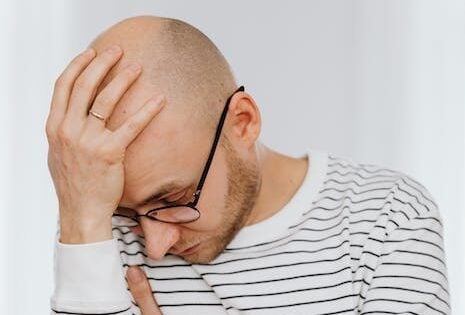Hair Loss in Men: Understanding Male Pattern Baldness
Table of contents
The loss of hair can be either temporary or permanent affecting the scalp alone or the body in its entirety. Hair loss on the head is more common in men though this can happen with anyone. The loss of hair can be a result of changes in the hormone, as part of aging, hereditary, or a medical condition. Baldness can be defined as the hair loss on the head in excess.
Male pattern baldness, also known as androgenic alopecia, which affects men, is a kind of hair loss that causes the loss of hair on your head, and the hair would not grow back. In men, male pattern baldness is the most common cause of loss of hair. Receding hairline (hairline that goes farther back on the head) and hair that is thinning are some of the other signs of male pattern baldness.

About Male Pattern Baldness/Hair loss
For every hair on the head, there is a cycle of growth. The cycle of growth weakens during male pattern baldness, and there is a shrinking of the hair follicles, causing the hair strands to become finer and shorter. With time, for each hair, the growth cycle will end, and there will not be any growth of new hair in that place. Typically, the hairline is the starting point of baldness in males. There is a gradual receding of the hairline forming a shape M. Oftentimes, there is the thinning and expansion of the vertex over time (usually a circular area on the back of the head). With time, the hair will become thinner, shorter, and finer. A hair pattern like a U-shape or horseshoe is formed around the head sides, and on the back of the head is a bald area.
In male pattern baldness, genetics has a major role to play. There is an increased risk of male pattern baldness among those who have close relatives with men who have male pattern baldness, especially for those whose relatives are from the maternal side. Though more prevalent in adult males, however, male pattern baldness can start in the adolescent years. The likelihood of one becoming bald will increase as the person advances in age.
About fifty percent of men above fifty years of age, according to the US National Library of Medicine (NLM), will be affected to an extent by male pattern baldness.
Stages of Hair Loss in Men

According to the scale of Hamilton-Norwood, male pattern baldness has seven stages.
- Stage 1: The loss of hair is little or none including recession of the hairline.
- Stage 2: Around the temples that are near the skin between the forehead and the ears, the loss of hair there is slight.
- Stage 3: There may be M or U shape hairline and the recession of the hair becomes very deep.
- Stage 4: On the crown of the head (that is the top of the head), you will see that there is a loss of hair there, and the recession of the hairline is very deep
- Stage 5: There is a connection on the crown of the receded hairline to the spot that is bald
- Stage 6: There is thinning or complete loss of the hair between the crown and the temple
- Stage 7: On top of the hair, there is no hair there, and around the side of the head is a thin band of hair.
Symptoms of Hair Loss in Men
They include the following:
- Hairline that is receding
- Loss or Thinning of the hair close to one’s temple
- On the crown, there could be loss or thinning of the hair
The male pattern baldness is not harmful. The early stages of male pattern baldness may begin in some individuals in their late teens or early twenties, although many begin to develop theirs in their thirties.
Causes
Genetics or a history of baldness in the family is a cause of male pattern baldness. It has been seen by researchers that there is an association of male pattern baldness with androgens, a male sex hormone that regulates the growth of hair among other functions.
Sometimes baldness may be a result of other conditions. These include
- Thyroid condition
- Stress
- Certain types of cancer
- Radiation or chemotherapy treatment
- Certain medications
- Anabolic steroids
- Infection of the scalp
If the loss happened after a new medication was taken or the hair loss is followed by other health issues, it is important to visit the doctor.
Prevention
Ways to prevent male pattern baldness are not yet known. According to a theory, stress may be associated with hair loss. Stress is believed to cause the production of sex hormones to increase. Participating in activities that relax the body like taking a walk can help to reduce stress.
Techniques to address hair loss
If the hair loss is not a result of any health condition, it will not be necessary to treat it medically. For men who are concerned about their looks and would prefer to have hair on the head, then some treatments are available for them. These include:
The use of wigs:
They come in different colors, sizes, styles, and textures. Using wigs can help cover hairlines that are receding, hairs that are thinning out, and those that are completely bald. A professional can help to create a wig that suits you and give you a natural look.
Hairstyle:
With the perfect right haircut, men with limited loss of hair can hide their hair loss. A hairstylist can help you with the right haircut to suit you.
The use of medication:
Some medications can be used to treat baldness. Minoxidil (Rogaine), a topical drug, which can be gotten over the counter, can be applied on the scalp to help with baldness. For the treatment of male pattern baldness, it is usually the first course of treatment. In some men, it slows the loss of hair and allows for the growth of hair by stimulating the follicles of the hair. It takes several months for any result to be seen. Side effects may include dryness, unusual hair growth, headaches, and scalp irritation.
Finasteride (Propecia, Proscar) is a prescription oral medication that regresses hair loss in some men by inhibiting the production of the male hormone that allows for the loss of hair. Hair loss returns once finasteride is stopped. For one to observe a change, finasteride needs to be for several months. The side effects may include itching, rash, hives, breast growth, tenderness of the breast, and erectile dysfunction.
The use of weaves:
Hair weaves can be sewn into the natural hair; they are also wigs. However, the hair on the head must be enough for the weave to be sewn into. A demerit of using weave is that whenever there is growth of new hair, the weave must be sewn again causing damage to the natural during the process of sewing. A merit of the use of weave is that the weave does not go off even when engaging in activities such as swimming or even sleeping.
Hair transplant:
This kind of treatment is expensive and invasive. This involves the removal of hair from areas where there is active growth of hair to areas of the scalp where balding or thinning of the hair has occurred. The side effects may include scarring, dizziness, irritation of the scalp, and pain in the scalp. One advantage of hair transplant is that it is permanent and gives a more natural look.
References
- https://www.healthline.com/health/male-pattern-baldness
- https://www.mayoclinic.org/diseases-conditions/hair-loss/symptoms-causes/syc-20372926#:~:text=It%20can%20be%20the%20result,most%20common%20cause%20of%20baldness.
- https://www.webmd.com/skin-problems-and-treatments/hair-loss/male-pattern-baldness
- https://my.clevelandclinic.org/health/diseases/24515-male-pattern-baldness-androgenic-alopecia
- https://www.pennmedicine.org/for-patients-and-visitors/patient-information/conditions-treated-a-to-z/male-pattern-baldness#:~:text=Male%20pattern%20baldness%20is%20related,the%20skin%20called%20a%20follicle.
The information provided in this blog is for educational purposes only and should not be considered as medical advice. It is not intended to replace professional medical consultation, diagnosis, or treatment. Always consult with a qualified healthcare provider before making any decisions regarding your health. Read more


